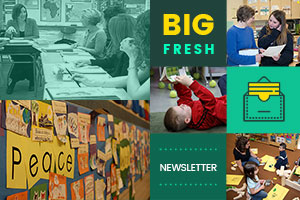The fire of literacy is created by the sparks between a child, a book, and the person reading.
Mem Fox
One day before winter break, my classroom was filled with blue food. We had blue punch, blue Jell-O, blue tortilla chips, and blue chocolate chip cookies. Why the color-themed food? We were celebrating the end of a class read-aloud, Rick Riordan’s The Lightning Thief.
Typically I avoid any rewards tied to reading. I believe reading needs to be its own reward. When it is tied to external motivation, the desire to read typically disappears when the rewards are removed. So why on earth would I have a “blue-food party” in my classroom?
I think reading rewards and celebrating books are two very different things. We had been “celebrating” The Lightning Thief during the weeks it took to read this book aloud. The bulletin board on the back wall had become Camp Half-Blood, with a map of the buildings and areas created by students in the class. A small tree in the classroom had been named Thalia and she guarded the borders of our classroom, just as she did in the book. It wasn’t unusual to see orange shirts on my students during those weeks we read the book, to represent the Camp Half-Blood T-shirts. A few students began to make necklaces for the others with beads on leather lanyards like the kids at camp received. When fan fiction with the characters from the book began to pop up in writing workshop, I knew the class was fully immersed in the world Riordan had created.
As a reader, I get this passion for a story. I’ve read a book and fallen so deeply into that world that the real world I inhabit begins to look dull in comparison. I’ve driven down the road and thought that a character would like something I’ve seen, only to remember they are fictional. Some of my fifth graders have experienced this already, but many have not. Our read-alouds are the vehicles in to this world of loving books.
So when my students and I gathered together on a cold winter day in Illinois and I turned the last pages of Percy’s story, they munched on blue food all around them. One boy commented that Percy was right — blue homemade chocolate chip cookies really were the best. Another said she wished that we could have blue Coca-Cola like Percy did at camp. And they all let out groans when I said, “the end” and closed the book.
Reading aloud to our students provides the opportunity to celebrate reading for the sake of reading. We get to bond over a story without concerns about reading levels or ability. For that month in winter we lived and breathed the story of a demigod on his quest to save the world. By the end, we had celebrated our community and grown a little bit closer, thanks to the worlds that we inhabited – both in the classroom and in our heads. That’s something to celebrate.
This week we look at creative approaches to read-alouds. Plus more as always — enjoy!
Katherine Sokolowski
Contributor, Choice Literacy
Katherine Sokolowski has taught for over 15 years in elementary schools, and currently teaches fifth grade in the same small town in central Illinois where she grew up. She regularly writes about teaching on her blog Read Write Reflect.
Free for All
[For sneak peeks at our upcoming features, quotes and extra links, follow Choice Literacy on Twitter: @ChoiceLiteracy or Facebook: http://www.facebook.com/ChoiceLiteracy or Pinterest: http://pinterest.com/choiceliteracy/]
Jan Burkins and Kim Yaris are using read-alouds as an intervention strategy with struggling learners:
http://www.choiceliteracy.com/articles-detail-view.php?id=2192
Katie Doherty finds read-alouds are a valuable tool for developing middle school writers:
http://www.choiceliteracy.com/articles-detail-view.php?=2174
For Members Only
Bitsy Parks describes her process over the years in increasing both the quality and quantity of read-alouds in her first-grade classroom:
http://www.choiceliteracy.com/articles-detail-view.php?id=2757
Maria Caplin explains how read-alouds do double duty in her fifth-grade classroom, as they help build a love for story and help students master key literacy and content area standards:
http://www.choiceliteracy.com/articles-detail-view.php?id=2764
Mandy Robek finds quick poetry read-alouds are a great way to transition between activities in her second-grade classroom and build a love of poems:
http://www.choiceliteracy.com/articles-detail-view.php?id=2657
Jennifer Schwanke shares her experience of having read-aloud go awry in a middle school classroom:
http://www.choiceliteracy.com/articles-detail-view.php?id=2532
New PD2Go: Aimee Buckner uses rereading as a strategy to deepen student understanding during read-alouds:
http://www.choiceliteracy.com/pd2go-11300
This video and workshop guide fulfill Common Core State Standard ELA-Literacy.RL.4.9: Compare and contrast the treatment of similar themes and topics (e.g., opposition of good and evil) and patterns of events (e.g., the quest) in stories, myths, and traditional literature from different cultures.
That’s all for this week!



